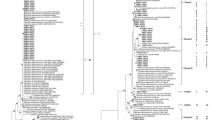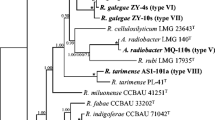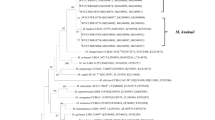Abstract
Aims
Rhizobia associated with white clover (Trifolium repens) grown in alkaline soils of China have never been investigated. This is the first survey to report of their genetic and biogeographical diversity.
Methods
Nodule bacteria were isolated from white clover grown in alkaline soils (pH 8.18–8.99) in North and East China and were characterized by multilocus sequence analysis (MLSA) of the housekeeping genes (atpD, recA, and glnII), and phylogenies of 16S rRNA gene and symbiotic genes nodC and nifH. The biogeographic distribution of rhizobial species was analyzed in relation to the soil factors.
Results
A total of 83 new strains could be affiliated to Rhizobium that shared 100 % sequence similarity of 16S rRNA gene with R. leguminosarum, R. acidisoli, R. anhuiense, R. indigoferae, R. sophorae, and R. laguerreae. Three genospecies were further distinguished based on the housekeeping gene analysis among these new strains: R. anhuiense, R. leguminosarum, and a hypothetical novel Rhizobium genospecies. Highly conserved symbiotic genes corresponding to those of symbiovar trifolii in R. leguminosarum were observed among all the new strains. Unique rhizobial communities associated with white clover were detected in the tested alkaline soils, and soil characteristics such as pH and nutrient levels were estimated as the determinant factors.
Conclusions
White clover established symbiosis with three Rhizobium genospecies harboring similar symbiotic genes in alkaline soils in China. Biogeographic pattern exists in clover rhizobia that was determined by the soil pH and nutrient levels.



Similar content being viewed by others
References
AFNOR (2005) Soil quality, determination of pH. NF ISO 10390. AFNOR, Paris
Appunu C, Sasirekha N, Prabavathy VR, Nair S (2009) A significant proportion of indigenous rhizobia from India associated with soybean (Glycine max L.) distinctly belong to Bradyrhizobium and Ensifer genera. Biol Fert Soils 46:57–63
Braak CT, Smilauer P (2002) CANOCO reference manual and CanoDraw for Windows user’s guide: sofware for canonical community ordination (version 4.5). Section on Permutation Methods Microcomputer Power, Ithaca, Newyork.
Duodu S, Carlsson G, Huss-Danell K, Svenning MM (2007) Large genotypic variation but small variation in N2 fixation among rhizobia nodulating red clover in soils of northern Scandinavia. J Appl Microbiol 102:1625–1635
Han L, Wang E, Han T, Liu J, Sui X, Chen W, Chen W (2009) Unique community structure and biogeography of soybean rhizobia in the saline-alkaline soils of Xinjiang, China. Plant Soil 324:291–305
Hill TC, Walsh KA, Harris JA, Moffett BF (2003) Using ecological diversity measures with bacterial communities. FEMS Microbiol Ecol 43:1–11
Jordan DC (1984) Family III. Rhizobiaceae Conn 1938, 321AL. In: Krieg NR, Holt JG (eds) Bergey’s manual of systematic bacteriology. Williams & Wilkins, Baltimore
Kumar N, Lad G, Giuntini E, Kaye M, Udomwong P, Shamsani N, Young J, Bailly X (2014) Bacterial genospecies that are not ecologically coherent: population genomics of Rhizobium leguminosarum. Open Biol 5:140133
Laguerre G, Mavingui P, Allard MR, Charnay MP, Louvrier P, Mazurier SI, Rigottier-Gois L, Amarger N (1996) Typing of rhizobia by PCR DNA fingerprinting and PCR-restriction fragment length polymorphism analysis of chromosomal and symbiotic gene regions: application to Rhizobium leguminosarum and its different biovars. Appl Environ Microbiol 62:2029–2036
Laguerre G, Nour SM, Macheret V, Sanjuan J, Drouin P, Amarger N (2001) Classification of rhizobia based on nodC and nifH gene analysis reveals a close phylogenetic relationship among Phaseolus vulgaris symbionts. Microbiol (England) 147:981–993
Lan R, Reeves PR (2000) Intraspecies variation in bacterial genomes: the need for a species genome concept. Trends Microbiol 8:396–401
Liu XY, Wang ET, Li Y, Chen WX (2007) Diverse bacteria isolated from root nodules of Trifolium, Crotalaria and Mimosa grown in the subtropical regions of China. Arch Microbiol 188:1–14
Man CX, Wang H, Chen WF, Sui XH, Wang ET, Chen WX (2008) Diverse rhizobia associated with soybean grown in the subtropical and tropical regions of China. Plant Soil 310:77–87
Marek-Kozaczuk M, Leszcz A, Wielbo J, Wdowiak-Wróbel S, Skorupska A (2013) Rhizobium pisi sv. trifolii K3.22 harboring nod genes of the Rhizobium leguminosarum sv. trifolii cluster. Syst Appl Microbiol 36:252–258
Martens M, Dawyndt P, Coopman R, Gillis M, De Vos P, Willems A (2008) Advantages of multilocus sequence analysis for taxonomic studies: a case study using 10 housekeeping genes in the genus Ensifer (including former Sinorhizobium). Int J Syst Evol Microbiol 58:200–214
Mauchline TH, Hayat R, Roberts R, Powers SJ, Hirsch PR (2014) Assessment of core and accessory genetic variation in Rhizobium leguminosarum symbiovar trifolii strains from diverse locations and host plants using PCR-based methods. Lett Appl Microbiol 59:238–246
Nei M, Li WH (1979) Mathematical model for studying genetic variation in terms of restriction endonucleases. Proc Natl Acad Sci U S A 76:5269–5273
Olsen SR (1954) Estimation of available phosphorus in soils by extraction with sodium bicarbonate. USDA, Washington, DC
Ormeño-Orrillo E, Servín-Garcidueñas LE, Rogel MA, González V, Peralta H, Mora J, Julio Martínez-Romero J, Martínez-Romero E (2015) Taxonomy of rhizobia and agrobacteria from the Rhizobiaceae family in light of genomics. Syst Appl Microbiol 38:287–291
Ramirez-Bahena MH, Velazquez E, Fernandez-Santos F, Peix A, Martinez-Molina E, Mateos PF (2009) Phenotypic, genotypic, and symbiotic diversities in strains nodulating clover in different soils in Spain. Can J Microbiol 55:1207–1216
Rivas R, Laranjo M, Mateos PF, Oliveira S, Martinez-Molina E, Velazquez E (2007) Strains of Mesorhizobium amorphae and Mesorhizobium tianshanense, carrying symbiotic genes of common chickpea endosymbiotic species, constitute a novel biovar (ciceri) capable of nodulating Cicer arietinum. Lett Appl Microbiol 44:412–418
Rogel MA, Ormeno-Orrillo E, Martinez Romero E (2011) Symbiovars in rhizobia reflect bacterial adaptation to legumes. Syst Appl Microbiol 34:96–104
Seguin P, Graham PH, Sheaffer CC, Ehlke NJ, Russelle MP (2001) Genetic diversity of rhizobia nodulating Trifolium ambiguum in North America. Can J Microbiol 47:81–85
Shamseldin A, Moawad H, Abd El-Rahim WM, Sadowsky MJ (2014) Near-full length sequencing of 16S rDNA and RFLP indicates that Rhizobium etli is the dominant species nodulating Egyptian winter Berseem clover (Trifolium alexandrinum L.). Syst Appl Microbiol 37:121–128
Simonis AD (1996) Effect of temperature on extraction of phosphorus and potassium from soils by various extracting solutions. Commun Soil Sci Plant Anal 27:665–684
Sullivan JT, Ronson CW (1998) Evolution of rhizobia by acquisition of a 500-kb symbiosis island that integrates into a phe-tRNA gene. Proc Natl Acad Sci U S A 95:5145–5149
Tamura K, Stecher G, Peterson D, Filipski A, Kumar S (2013) MEGA6: molecular evolutionary genetics analysis version 6.0. Mol Biol Evol 30:2725–2729
Terefework Z, Kaijalainen S, Lindstrom K (2001) AFLP fingerprinting as a tool to study the genetic diversity of Rhizobium galegae isolated from Galega orientalis and Galega officinalis. J Biotechnol 91:169–180
Tesfaye M, Holl FB (1999) Rhizobium strains that nodulate Trifolium semipilosum Fres. are phylogenetically distinct. Plant Soil 207:147–154
Vincent JM (1970) A manual for the practical study of root nodule bacteria. International Biological Programme (By) Blackwell Scientific, Oxford
Vinuesa P, Silva C, Lorite MJ, Izaguirre-Mayoral ML, Bedmar EJ, Martinez-Romero E (2005a) Molecular systematics of rhizobia based on maximum likelihood and Bayesian phylogenies inferred from rrs, atpD, recA and nifH sequences, and their use in the classification of Sesbania microsymbionts from Venezuelan wetlands. Syst Appl Microbiol 28:702–716
Vinuesa P, Silva C, Werner D, Martínez-Romero E (2005b) Population genetics and phylogenetic inference in bacterial molecular systematics: the roles of migration and recombination in Bradyrhizobium species cohesion and delineation. Mol Phylogenet Evol 34:29–54
Wang E, Van Berkum P, Sui X, Beyene D, Chen W, Martínez-Romero E (1999) Diversity of rhizobia associated with Amorpha fruticosa isolated from Chinese soils and description of Mesorhizobium amorphae sp. nov. Int J Syst Bacteriol 49:51–65
Wei G, Chen W, Zhu W, Chen C, Young JPW, Bontemps C (2009) Invasive Robinia pseudoacacia in China is nodulated by Mesorhizobium and Sinorhizobium species that share similar nodulation genes with native American symbionts. FEMS Microbiol Ecol 68:320–328
Wernegreen JJ, Riley MA (1999) Comparison of the evolutionary dynamics of symbiotic and housekeeping loci: a case for the genetic coherence of rhizobial lineages. Mol Biol Evol 16:98–113
Zhang YM, Li Y Jr, Chen WF, Wang ET, Tian CF, Li QQ, Zhang YZ, Sui XH, Chen WX (2011) Biodiversity and biogeography of rhizobia associated with soybean plants grown in the North China Plain. Appl Environ Microbiol 77:6331–6342
Zhang J, Lou K, Jin X, Mao P, Wang E, Tian C, Sui X, Chen W, Chen W (2012) Distinctive Mesorhizobium populations associated with Cicer arietinum L. in alkaline soils of Xinjiang, China. Plant Soil 353:123–134
Zhang YJ, Zheng WT, Everall I, Young JP, Zhang XX, Tian CF, Sui XH, Wang ET, Chen WX (2015) Rhizobium anhuiense sp. nov. isolated from effective nodules of Vicia faba and Pisum sativum. Int J Syst Evol Microbiol 65:2960–2967
Acknowledgments
This work was financed by the National Natural Science Foundation of China (Project No. 31400008) and the Scientific Research Funds of Zhengzhou University of Light Industry (Project No. 2014bsjj006). ETW is financially supported by grants SIP20150597 authorized by Instituto Politécnico Nacional, Mexico. Thanks to JunWei Zhang from Ruzhou and Xianchao Yang from Shanghai for assistance in the soil sampling.
Author information
Authors and Affiliations
Corresponding author
Additional information
Responsible Editor: Katharina Pawlowski.
Electronic supplementary material
Below is the link to the electronic supplementary material.
ESM 1
(PPTX 260 kb)
Rights and permissions
About this article
Cite this article
Zhang, J.J., Jing, X.Y., de Lajudie, P. et al. Association of white clover (Trifolium repens L.) with rhizobia of sv. trifolii belonging to three genomic species in alkaline soils in North and East China. Plant Soil 407, 417–427 (2016). https://doi.org/10.1007/s11104-016-2899-9
Received:
Accepted:
Published:
Issue Date:
DOI: https://doi.org/10.1007/s11104-016-2899-9




